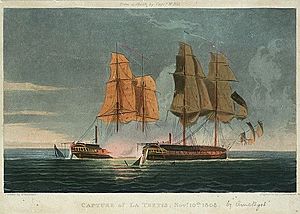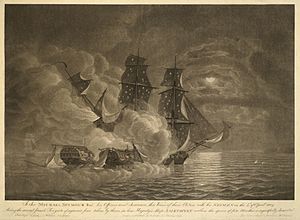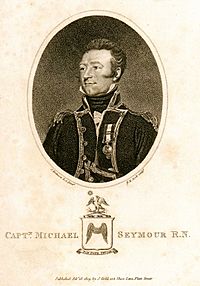HMS Amethyst (1799) facts for kids

Capture of the Thétis by HMS Amethyst on 10 November 1808, by Thomas Whitcombe
|
|
Quick facts for kids History |
|
|---|---|
| Name | HMS Amethyst |
| Builder | Deptford Dockyard |
| Launched | 24 April 1799 |
| Honours and awards |
|
| Fate |
|
| General characteristics | |
| Class and type | Penelope-class frigate |
| Tons burthen | 104548⁄94 (bm) |
| Length | 150 ft (45.7 m) (overall); 125 ft 5+3⁄8 in (38.2 m) (keel) |
| Beam | 39 ft 7 in (12.1 m) |
| Depth of hold | 13 ft 0 in (4.0 m) |
| Sail plan | Full-rigged ship |
| Complement | 274 |
| Armament |
|
HMS Amethyst was a 36-gun frigate of the Royal Navy, built in 1799. She was part of the Penelope-class, known for being fast and powerful warships. Amethyst played a role in both the French Revolutionary Wars and the Napoleonic Wars. During her service, she captured many enemy ships and took part in important battles. Her crew even earned special medals for their bravery. Sadly, Amethyst was badly damaged in a storm and had to be taken apart in 1811.
Contents
Amethyst in the French Revolutionary Wars
Amethyst began her service in May 1799 under Captain John Cooke. She first operated near the Dutch coast. During the Anglo-Russian invasion of Holland, Amethyst helped transport the Duke of York to the Netherlands. She also helped evacuate troops after the campaign ended.
Capturing Enemy Ships
In December 1799, Amethyst and another ship, Beaulieu, recaptured a brig named Jenny. A few days later, they also recaptured four more ships: Dauphin, Cato, Cabrus, and Nymphe.
On December 29, Amethyst captured a French privateer brig called Aventurier. A privateer was a private ship allowed by a government to attack enemy ships. Aventurier had 14 guns and 75 men. She had previously captured an American ship, Cato. Captain Cooke freed the American prisoners and sent Aventurier to Plymouth.
In January 1800, Amethyst captured the French armed ship Huzelle. This ship was carrying passengers, including women and children. Huzelle was later recaptured by other British ships and brought into Plymouth.
Joining Forces in Battle
In February 1800, Amethyst joined Oiseaux and Sirius in chasing the French frigate Dédaigneuse. Oiseaux and Sirius captured her, and she later joined the Royal Navy as HMS Dedaigneuse.
On February 15, Amethyst and Nymphe captured the French privateer cutter Valiant. Valiant had 15 guns and 131 men. She had not captured any ships yet.
A few days later, Nymphe and Amethyst captured the French merchant ship Modeste. She was carrying valuable goods like cotton, coffee, and sugar. They also recaptured two other ships, Active and Amity.
On March 31, Amethyst and Nymphe captured the French privateer Mars. Mars was a large privateer with 22 guns and 180 men. The British later used Mars in their own navy as Garland.
Daring Boat Attacks
In July 1800, a small group of volunteers from Amethyst and other ships launched a daring boat attack. Led by Lieutenant Jeremiah Coghlan, they captured the French naval brig Cerbère. This brig was heavily armed and guarded by three shore batteries. The British boarding party had only 20 men and lost one killed and eight wounded. The French lost 6 killed and 20 wounded. This brave act earned the surviving crew members a special medal.
In August 1800, Amethyst also took part in another boat attack in Vigo Bay, Spain. A large group of boats from several British ships captured the French privateer Guêpe. Guêpe had 18 guns and 161 men. The French lost 25 men killed and 40 wounded in this attack. The British also suffered casualties, with 4 killed and 23 wounded. This action also earned the crew a medal.
More Captures and Patrols
In 1801, Amethyst continued to operate off Spain. She captured two Spanish privateers and a French warship called Général Brune. On January 28, Amethyst and Sirius captured the Spanish merchant ship Charlotta.
On March 16, Amethyst captured the Spanish privateer schooner Nostra Signora del Carmen. She had 6 guns and 65 men. Captain Cooke decided to destroy her because she was not suitable for the navy.
On April 12, Amethyst captured the French navy corvette General Brune. This ship was carrying the former governor of Guadeloupe and his staff.
Later in 1801, Captain Charles Taylor took command, followed by Captain Henry Glynn. During a time of peace, Amethyst patrolled the coast of Scotland to stop smuggling.
Amethyst in the Napoleonic Wars
Before the Napoleonic Wars began, the Royal Navy started gathering more sailors. This often involved "impressment," where sailors were forced into naval service. In March 1803, Amethyst was involved in an attempt to impress sailors from two large merchant ships, Woodford and Ganges. The merchant sailors fought back, not wanting to join the navy. Two sailors on Woodford were killed, but the press gangs were not able to get many men.
New Commanders and More Action
In June 1804, Captain John Spranger took command of Amethyst. She continued to capture enemy ships. On July 24, Amethyst and Magicienne captured Agnela. She also captured Ebenezer and Juno in August.
In November 1805, Amethyst accidentally exchanged fire with another British ship, Wolverine. Both ships survived, and their captains later exchanged letters about the misunderstanding.
Captain Michael Seymour became the new commander. On May 15, 1807, Amethyst captured the privateer Josephine. Josephine had 4 guns and 45 men. She had only captured one ship before Amethyst caught her.
Later that year, Amethyst captured the Danish ship Twende Venner and recaptured the American brig Rising Sun.
Famous Victories
On November 10, 1808, Amethyst had a major battle with the French frigate Thétis. This was a fierce fight. Amethyst had 19 men killed and 51 wounded. The French ship had even heavier losses, with 135 dead and 102 wounded. Amethyst was badly damaged, taking 71 days to repair. Captain Seymour was greatly honored for this victory. He received a special medal and money for the wounded crew. The Royal Navy bought Thétis and renamed her HMS Brune. Survivors of this battle also received a medal.

In 1809, Amethyst was part of a squadron near Rochefort. In April, she captured another French frigate, Niémen. Niémen lost 47 men killed and 73 wounded. Amethyst had 8 killed and 37 wounded. This victory also earned the crew a medal.
Later that year, Captain Seymour left the ship, and Captain Jacob Walton took command.
The End of Amethyst
On February 15, 1811, Amethyst was anchored in Plymouth Sound. She was preparing to sail the next day to join the fleet. Captain Walton decided to use only one anchor. A strong storm hit the ship, blowing her onto the rocks near Cony Cliff Rocks.
Lines were quickly passed to the shore, allowing most of the crew to get to safety. However, eight men sadly died. Most of the ship's supplies were saved over the next few days. But the ship was too badly damaged to be repaired. By March 10, the waves had completely broken apart her hull.
A naval court later found Captain Walton and the ship's master, Robert Owen, negligent. They were criticized for anchoring the ship too close to shore with only one anchor. Owen was also banned from serving on larger ships for a year.



